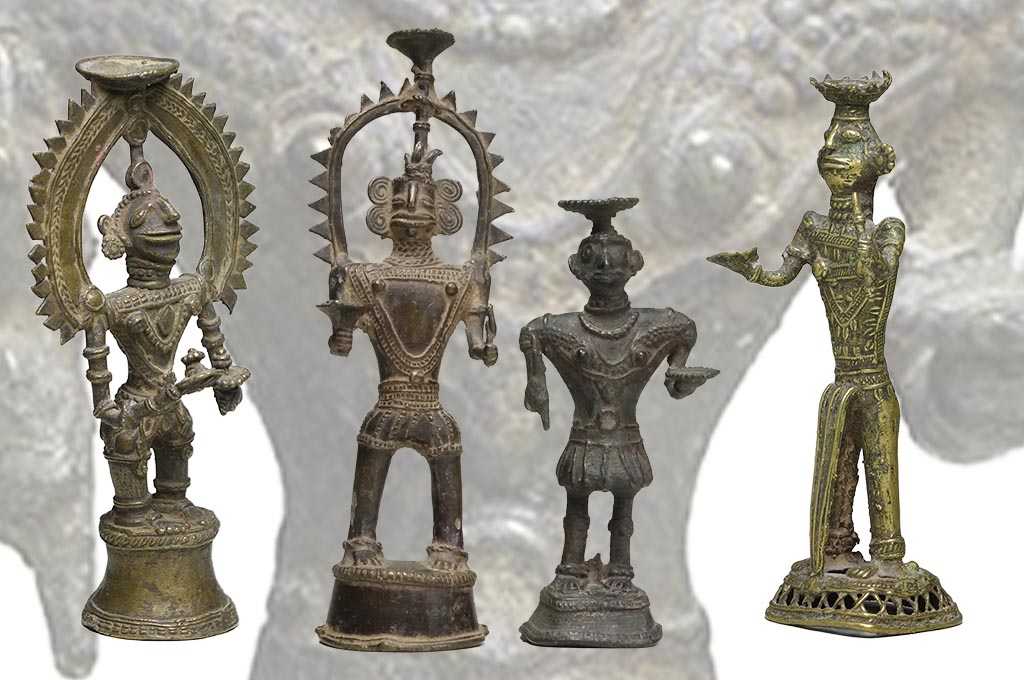
07 May TRIBAL ART OF BASTAR
di Renzo Freschi
Did you know that vast areas of India have always been inhabited by ethnic groups that were defined in 1930 as Adivasi, a Sanskrit term meaning aborigenes, autochtons, in the sense of populations that were there long before the Indo-Aryan invasions? Some of these populations were discovered in the 19th century by the British, even though their census only began after India gained its independence (1947). Protected for centuries by an extremely hostile environment in which jungles and rugged hills made access almost impossible, it was only in the 1960s and 70s that the central government, anthropologists, and many European and American museums finally granted these people more dignity.
Starting from those years, and even more so after the beginning of this century, economic development and improved communications affecting the whole of India also influenced the Adivasi, bringing indubitable benefits but also changes that might jeopardize their identity. The region that still hosts an important concentration of tribal groups with peculiar customs and cults is called Bastar and it covers a large area of central India.
Two figures of the goddess Dantesvari (?)
India, Bastar, 20th century
Brass, lost wax process
H. 16 and 20 cm
These groups of erstwhile hunter-gatherers now turned into farmers and workers still maintain their own cults and beliefs in spite of the heavy influence of Hinduism. They are essentially animists who in some cases represent the divinity through symbols that may vary depending on the various ethnicities. More often their pantheons feature identical figures of gods, but worshiped under different names. It is a “fluid” iconography, which under special circumstances sees Hindus venerating tribal divinities and vice versa. Bastar statues are made as offerings for the temple – usually a simple, summarily covered altar in the open air on which lots of images are amassed – or alternatively as offerings meant to obtain a special grace from the divinity. In case the prayer is not fulfilled the image is recovered and sold, an act of spontaneous pragmatism.
The statues are made by a caste of craftsmen specializing in the production of metal objects: statues of divinities but also common implements. A peculiar aspect is that sacred images are described to the manufacturer by a priest or medium who saw them in a dream, a practice reminiscent of some shamanic traditions.
Pardesin Mata (?)
India, Bastar
First half of 20th century
Brass, lost wax casting
H. 20 cm
The technique used by the craftsmen is that of lost wax, consisting in modelling clay or another inert material into the approximate shape of the desired object. This form is then covered with a layer of more carefully modeled wax, which is in turn covered in clay. The whole is then placed on a fire, the heat melts the wax which drains through specially provided openings so that the empty space can be filled with molten metal poured through the same apertures. After cooling off, the outer clay is smashed and the statue appears, which will then be hand finished and chiseled. This very ancient technique is still employed by many Adivasi cultures, as it can be used anywhere with limited resources.
Lasura Ravana
India, Bastar, 20th century
Brass, lost wax casting
H. 30 cm
Private collection
Four-armed Deity
India, Bastar, 20th century
Brass, lost wax casting
H. 13 cm
Telangin Mata (?)
India, Bastar, 20th century
Brass, lost wax process
H. 16 cm
Mata Devi (?)
India, Bastar, Mid-20th century
Brass, lost wax casting
H. 16 cm
What we said, whilst no doubt useful for a basic knowledge of Bastar culture in the various ethnic groups, still does not deal with the most fascinating aspect of their art: the style and shape of their statues.
The first time I saw these statuettes from the Berger collection I wondered whether they could be images of robots, of aliens, of extraterrestrials created by some science fiction artist. Their crude and naive look had and still has an irresistible charm for those who, like me, are used to the perfect harmony of classical Hindu statues, in which the sacred observes very strict canons tending to perfection. Thus these disproportionate statuettes, with awkward bodies wholly covered in strange ornaments, protected by aureoles rising from their shoulders, with bulging eyes, wide shoulders like wrestlers and narrow waistlines like dancers seem to be the product of a free, dreamlike, but also joyful fantasy, for they are all images of protectors, or rather protectresses, since they are almost invariably female.
Two figures on a swing
India, Bastar, mid 20th century
Brass, lost wax casting
10 x 11 cm
Seven mother goddesses
India, Bastar, 20th century
Brass, lost wax casting
H. 7 by 12 cm
Private collection
This unique and characteristic style of Bastar “bronzes” (they are really made of brass) originated in the 11th-12th century, when some areas in the region were occupied by the army of a Hindu king who had temples erected in the classical style of Hindu architecture. However, the craftsmen who were tasked with decorating temple walls with images of divinities were not competent enough and this resulted in square, simplified figures copied “from memory” by mediocre artisans. But these statues gradually turned into a “regional” model with a difference: those of stone stuck to the original style through the centuries, while those of metal made by the Adivasi elaborated freer and more spontaneous forms, a style that was no longer a bad copy of a classical sculpture, but an original tribal form which can be considered true art. However, Bastar art is not limited to the bizarre figures representing the pantheon of the various tribes. It is also expressed in the material culture that includes objects of both daily and ritual use. There is an interesting difference though, for while the statues of divinities have crude forms and are roughly finished, practical objects by contrast reveal a remarkable aesthetic and formal taste. It thus happens that a particularly talented artisan can make, always using the lost-wax process, implements like this grain vessel, where the ultra thin metal ribbing creates a pattern embellished with geometric shapes (rhombuses, bands, rosettes) which make it an exquisite work of art.
da sin. a ds.
Khanda Kankalini (?)
India, Bastar, 20th century
Brass, lost wax casting
H. 10 cm
Grain measuring vessel
India, Bastar, 20th century
Brass, lost wax casting
13 cm by 16 cm diam
Two female goddesses
India, Bastar, 20th century
Brass, lost wax casting
H. 11 and 12 cm




























No Comments